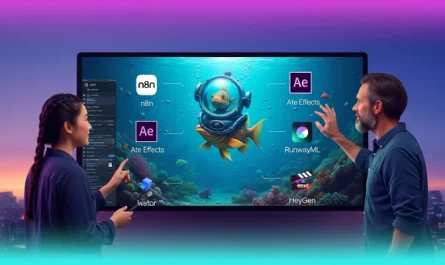Introduction
In today’s digital age, creativity is undergoing a significant transformation. Artificial Intelligence (AI) is no longer just a tool for automation; it’s becoming a collaborative partner in the creative process. One of the most impactful ways AI is influencing creativity is through prompt-based design. This approach allows designers, marketers, and creatives to generate visual and textual content by simply providing descriptive prompts to AI systems. The result is faster ideation, enhanced collaboration, and more dynamic marketing strategies.
Summary
Prompt-based design leverages AI’s ability to interpret natural language instructions to produce creative outputs. Tools like Midjourney, DALL·E, and Adobe Firefly enable users to generate images, graphics, and even video storyboards from textual descriptions. This method accelerates the creative process, reduces costs, and democratizes design by allowing individuals without formal design training to contribute ideas.
In integrated marketing, AI-driven prompt-based design is revolutionizing campaign development. Marketers can quickly produce visuals for social media, advertisements, and other content, ensuring consistency and relevance across platforms. Moreover, AI’s ability to analyze data and trends enables the creation of content that resonates with target audiences, enhancing engagement and effectiveness.
Understanding Prompt-Based Design
What Is Prompt-Based Design?
Prompt-based design is the process of generating creative content by providing AI systems with natural language instructions. For instance, a user might input, “Create a futuristic city skyline at sunset,” and the AI would generate an image based on that description. This approach streamlines the creative process, allowing for rapid prototyping and iteration.
The Role of Generative AI
Generative AI models, such as OpenAI’s DALL·E and Midjourney, have been trained on vast datasets to understand and generate visual content from textual descriptions. These models use advanced algorithms to interpret prompts and produce images that align with the given instructions. The result is high-quality visuals created in a fraction of the time it would take using traditional methods.
AI in Integrated Marketing
Streamlining Campaign Development
In integrated marketing, consistency across various platforms is crucial. AI-driven prompt-based design allows marketers to generate consistent visuals for websites, social media, email campaigns, and advertisements. This consistency ensures that the brand message is cohesive and recognizable across all touchpoints.
Enhancing Audience Engagement
AI’s ability to analyze consumer data enables the creation of personalized content that resonates with specific audiences. By understanding preferences, behaviors, and trends, AI can help marketers craft messages and visuals that are more likely to engage and convert their target demographic.
Reducing Costs and Time
Traditional content creation methods can be time-consuming and expensive. AI-driven prompt-based design reduces the need for extensive photoshoots, graphic design work, and revisions. This not only cuts costs but also accelerates the time-to-market for campaigns, allowing brands to respond more swiftly to market changes.
The Human-AI Collaboration
Complementing Human Creativity
While AI can generate impressive visuals and content, human creativity remains at the core of meaningful design. AI serves as a tool that complements and enhances human creativity. Designers and marketers provide the vision, strategy, and emotional intelligence that AI lacks, ensuring that the final output aligns with the brand’s values and objectives.
Ethical Considerations
The use of AI in creative processes raises ethical questions, particularly concerning originality and copyright. It’s essential for organizations to establish clear guidelines regarding the ownership of AI-generated content and ensure that the use of AI respects intellectual property rights.
Challenges and Considerations
Over-Reliance on AI
There’s a risk that over-reliance on AI could stifle human creativity. It’s important to use AI as a supportive tool rather than a replacement for human ingenuity. Balancing AI capabilities with human input ensures that creativity remains dynamic and innovative.
Quality Control
AI-generated content may not always meet the desired quality standards. It’s crucial to have human oversight to review and refine AI outputs, ensuring they align with brand guidelines and quality expectations.
Future Outlook
The integration of AI in creative processes is expected to grow, with advancements leading to even more sophisticated tools and capabilities. As AI continues to evolve, it will offer new opportunities for creativity, personalization, and efficiency in design and marketing. However, the human touch will remain indispensable in guiding AI to produce meaningful and impactful content.
Conclusion
AI is undeniably transforming the landscape of creativity through prompt-based design. By enabling rapid content generation, enhancing collaboration, and streamlining marketing efforts, AI is empowering creators and marketers to push the boundaries of innovation. However, it’s essential to maintain a balance, ensuring that human creativity and ethical considerations guide the use of AI in the creative process. Embracing this collaboration will lead to a future where technology and human ingenuity work hand in hand to produce exceptional creative outcomes.
10 Trending FAQs on Prompt-Based Design
- What is prompt-based design?
It’s the use of AI tools to generate visuals or creatives based on natural language prompts. - Can prompt-based design replace graphic designers?
No. It supports designers by speeding up ideation, but final creativity still needs a human touch. - Which AI tools are best for design prompts?
Tools like Midjourney, DALL·E, Adobe Firefly, and Figma AI are currently leading. - Is prompt-based design only for images?
No, it extends to video, animation, UI/UX mockups, and even sound design. - Do creative agencies use prompt-based design now?
Yes, top creative agencies in India already integrate it into their workflows. - How can prompt-based design help small marketing teams?
It saves time and cost on initial drafts, enabling faster execution and creativity. - Can AI understand brand guidelines?
Not fully. Designers still need to ensure consistency and brand alignment. - Is AI content copyright protected?
This is a gray area. Most AI tools now come with guidelines on usage rights. - Are clients open to AI-generated visuals?
Many are, especially when they see faster turnarounds and more visual options. - How can I start using prompt-based design?
Begin with free tools like DALL·E or Canva’s AI features and learn prompt crafting through experimentation.
Some of the services that Clevertize provides are:
Creative Services, Performance & Digital Media Marketing, Visual Identity & Branding, Campaign Management & Analysis, UI/UX & Website design, Video creation, Media planning & buying, Chatbot & more.
If Return on Investment is critical for you, talk to Clevertize!
Reach out to us at saumya@clevertize.com





